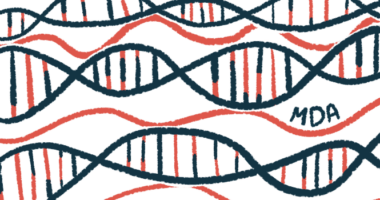Voyager, Novartis join to advance next-generation SMA gene therapy
Potential seen for safer and more effective disease treatment

Voyager Therapeutics is collaborating with Novartis to discover and develop next-generation gene therapies for conditions like spinal muscular atrophy (SMA).
Under terms of the agreement, Novartis will obtain a target-exclusive license to Voyager’s TRACER capsids for SMA and Huntington’s disease, and it will be responsible for the development and commercialization of a resulting therapy for SMA.
“Combining the proven capabilities of Novartis in gene therapy development and commercialization with Voyager’s next-generation TRACER capsids and payloads could enable the advancement of important new therapies for patients,” Alfred W. Sandrock, MD, PhD, Voyager’s CEO, said in a company press release.
Potential seen for a next-generation SMA gene therapy
Voyager will advance potential treatments in preclinical testing. It is receiving an upfront payment of $100 million, and the possibility of up to $1.2 billion in additional payments as certain preclinical, development, regulatory, and sales milestones are achieved. The company will be eligible for tiered royalties on global net sales of approved products incorporating its technology.
“We look forward to broadening our work with Voyager to help bring forward novel, high-impact gene therapies with the potential to improve the lives of patients affected by severe neurologic conditions,” said Fiona Marshall, PhD, president of biomedical research at Novartis.
SMA is caused by mutations in the SMN1 gene, resulting in little or no production of the survival motor neuron (SMN) protein. SMN’s lack leads to the progressive loss of motor neurons, the specialized nerve cells that control voluntary movements, and disease symptoms marked by muscle weakness and atrophy.
While there is an SMN2 gene, a slight difference in its DNA sequence — through a process called alternative splicing — limits the amount of functional SMN produced. This natural process alters the pieces of genetic information included in messenger RNA (a molecule derived from DNA that guides protein production) to create different proteins. In SMA, alternative splicing causes SMN2 to produce an SMN protein that’s shorter and less stable.
Several SMA therapies work to slow or stop SMA progression by increasing the production of SMN. These include Evrysdi (risdiplam) and Spinraza (nusinersen), treatments that correct alternative splicing, and the gene therapy Zolgensma that delivers a healthy SMN1 gene using an virus (AAV) as a transport vehicle.
Voyager’s AAV-based capsids may be safer, more effective than current AAVs
Using its TRACER discovery platform, Voyager has developed new AAV-based capsids — a viral shell composed of several proteins that enclose genetic material — that can penetrate the blood-brain barrier and are reported to enhance AAV delivery to the central nervous system (CNS, brain and spinal cord). AAV capsids are used in Zolgensma and other gene therapies to deliver therapeutic genes into cells.
In preclinical studies, TRACER-generated capsids demonstrated widespread gene expression in the CNS compared to conventional AAV capsids like AAV9 — the one used in Zolgensma — as well as cell- and tissue-specific transduction, including in often difficult-to-reach brain areas. Lesser effects on the liver and “de-targeting” of sensory nerve cells known as dorsal root ganglia also were seen.
Likewise, Voyager reports that its capsids had 100 times higher CNS penetration than AAV9.
“We believe Voyager’s TRACER capsids hold promise for enabling next-generation gene therapies for diseases of the central nervous system,” Marshall said.
The agreement also gives Novartis worldwide rights to a potential Huntington’s gene therapy, and responsibility for its clinical development and commercialization. Voyager again will be responsible for the therapy’s preclinical advancement.








